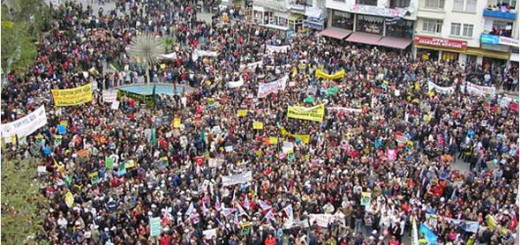Can Taiwan Phase out Nuclear Power? – Report on the NNAF 2019 Field Trip to Taiwan’s NPPs
by Tony Boys
The No Nukes Asia Forum (NNAF) is held in different Asian countries or regions each year. This year, the 19th forum over 26 years was hosted by the Taiwan Environmental Protection Union (TEPU). The forum consisted of a two-day (September 21 and 22) conference-style meeting in Taipei and an optional three-day (September 23-25) field trip to visit all four of Taiwan’s nuclear power plant (NPP) sites. This article focuses on the field trip.
1. Background
Taiwan is one of the few countries in the world that have, or have had, operating NPPs and then have later declared a nuclear phaseout. Of about 30 countries with operating NPPs, Belgium, Germany, Sweden, South Korea, Switzerland, and now Taiwan, have declared a phaseout. Italy completed its nuclear phaseout in 1990 and attempts to construct new plants since then have been blocked by public opposition. A few other countries have planned NPPs or have begun construction work on them only to decide later that they would not go ahead with nuclear power. Examples are Austria, the Philippines, Thailand and Vietnam.
In Taiwan, the Kuo Min Tang (KMT) party originally planned to build twelve NPPs of two reactors each. Only three NPPs have been constructed and the construction of one further NPP, the No.4 “Longmen” NPP, has been suspended. The reactors of the first, Jinshan NPP, were commissioned on December 10, 1978 and July 15, 1979. The construction of the Longmen NPP was begun in 1999 and will likely never be completed. While opposition to nuclear power in Taiwan was begun by intellectuals in the early 1980s, the first critical blow against nuclear power came in 2014, with a series of mass protests in Taipei from March 8 to April 27. (These included the occupation of the Taiwan legislature from March 18 to April 10, known as the Sunflower Student Movement, which was protesting the ratification of the Taiwan-China Cross-Strait Service Trade Agreement. Thus, Taiwan’s democratization, the Sunflower Student Movement and anti-nuke opposition are all inextricably linked.). The second critical blow came in 2016, when Tsai Ingwen’s Democratic People’s Party (DPP) won the presidential election, pledging to shut down existing NPPs as they reached the end of their 40-year lifetime and not complete the construction of NPP No.4. However, a win by the KMT in upcoming elections to be held on January 11, 2020 could reverse these decisions.
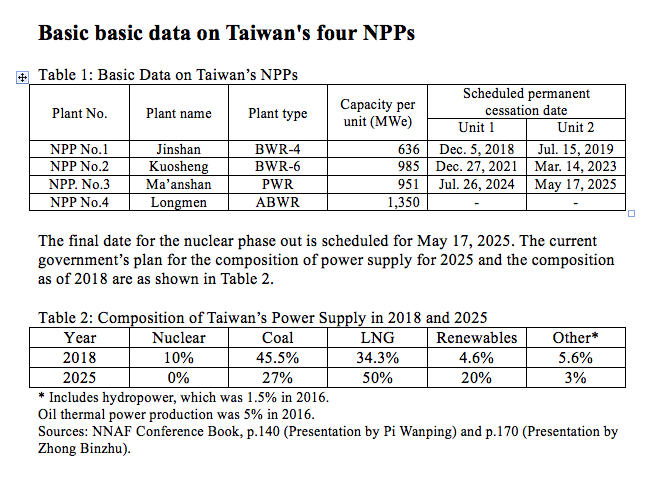
2. The Field Trip
The field trip began with a walk to Taiwan’s legislature for a reception with the Vice President of the Republic of China (Taiwan) Chen Chien-ren, who emphasized that the current government will phase out nuclear power in Taiwan by 2025, the year when the most recently commissioned reactor (“Ma’ashan” NPP No.3, Unit 2) reaches the end of its 40-year lifetime. Being welcomed to a reception by the vice president of a country is a nice change for a group of anti-nuke activists! It was also great having a couple of Nobel Peace Prize winners in our group! Dave Sweeny from Australia, representing the International Campaign to Abolish Nuclear Weapons (ICAN) and Erdenetsogt Dorjpalam from Mongolia of the Organization for the Prohibition of Chemical Weapons.
NPP No.2
After the reception, the group boarded a tour bus to visit the three NPPs in the northeast corner of Taiwan. The first stop was at a beach about an hour out of Taipei. Here we picked up our local activist guide, Mr. Guo Qinglin. Mr. Guo explained that this is a very dangerous area with three NPPs, requiring an immediate response to nuclear disasters in the case of earthquakes, but this planning only began in 2014 and is still ongoing. At the same time, the area has a wonderful scenic coastline, considered to be the most beautiful in Taiwan, to which the local people would like to attract tourists.
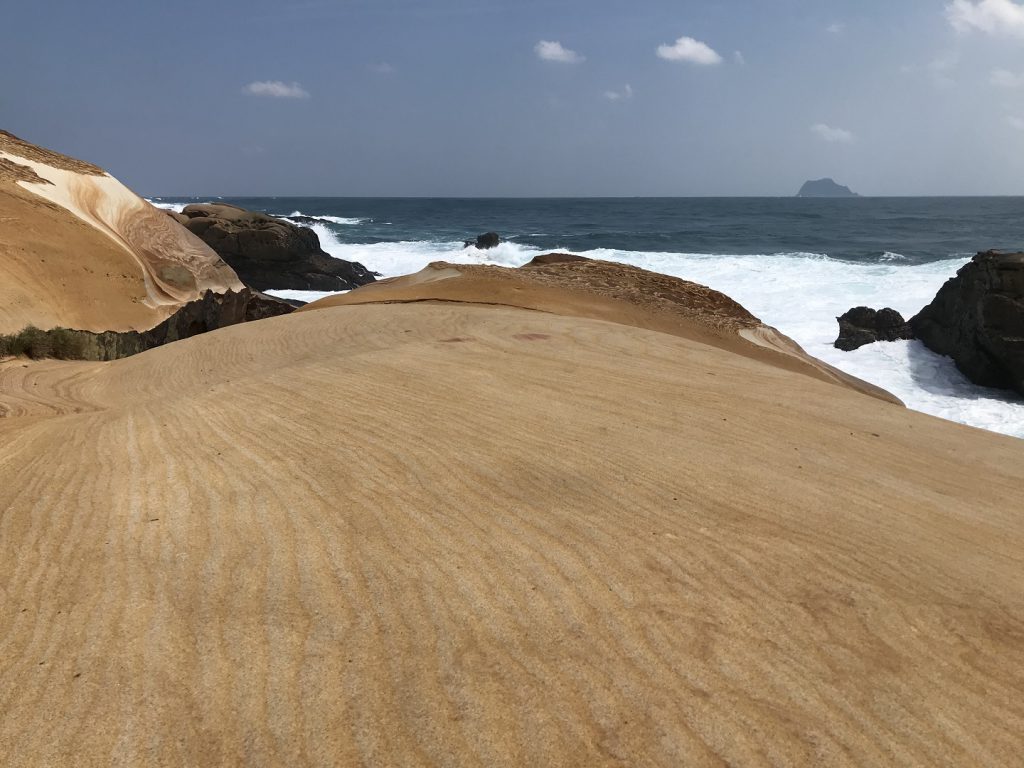
Offshore, a few kilometers away, we could see two rock formations. These are part of a row of volcanoes, beyond which is an active fault that does a 90 degree turn a little further north (more about this later).
After a few more kilometers in the bus we reached the NPP No.2 water intake which we viewed from inside the bus. Around eight million metric tons a day pass through this intake into the NPP cooling system, so it is not hard to imagine the effects on fish and the sea environment surrounding the intake, and also the outlet, which is just beyond the NPP. Mr. Guo carried out a survey of the intake in 1987. Large amounts of fish were passing through the cooling system. As the fish were killed when they were sucked into the water intake, they had to be removed. This was done by putting the dead fish into burlap sacks and carrying them up to an area in the mountains in old, unmarked trucks. The fish were then buried in ditches. The grass is beautifully lush and green in that area now.
At the water intake it is possible to scoop up 40 kg of fish in five minutes, which the NPP employees often do. Legislators and local officials have also now forced Taipower, the operator of all NPPs on Taiwan, to compensate local fishing people for the damage to fish catches caused by the NPP. The NPP water intakes and outlets also bring about changes in the water flow in the area, which can result in the denuding of beaches.
The bus then moved on past the two reactors, clearly visible on the left at a slightly higher elevation, and turned right to park near the water outlet. Warm water at 41C was rushing out into the sea. We were told that we would be able to smell the sodium hypochlorite (NaOCl2) that is added to the water to stun fish and prevent them from sticking to the walls of the cooling system, but I was not able to smell anything ‘unusual’. Since 1993, Taipower has also been putting charcoal in the water, perhaps to try to absorb the smell and the radiation. Mr. Guo showed us photos of deformed fish that had been caught in the area. Causality is not determined, but local fishermen claim that nine out of ten fish caught are deformed in some way. The water outlet temperature, chemicals and radiation have also caused a great decline in local fish species. Where there were around 100 species of fish in the sea areas near the NPP 30 years ago, fifteen years ago this had dropped to around 60 species and then to 30 species in recent years.
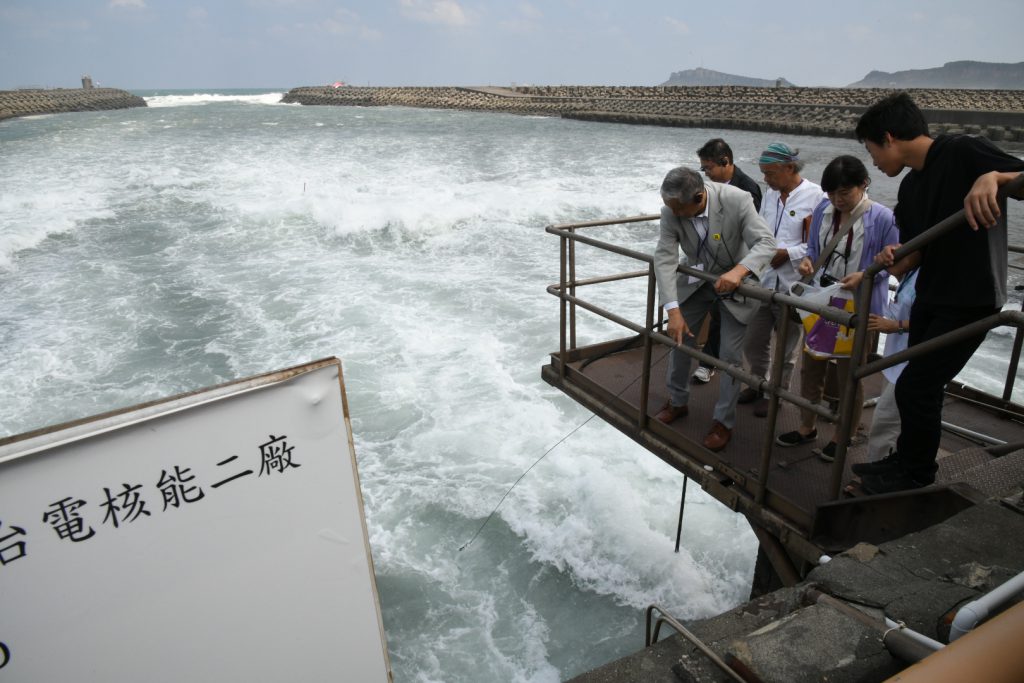
We then reboarded the bus and went to a local restaurant for lunch. There were three cars parked in the restaurant car park and four or five men standing around. We were told they were NPP security personnel. Regardless of who is in power in the central government, anti-nuke activists have always been treated like terrorists in the vicinity of NPPs. This is because the NPPs were built during the martial law era (May 1949 to July 1987). When the NPPs were constructed, people were simply forced off the land by government order.
After lunch we were taken to a place nearby where the shore could be seen on one side and a flat area of land beyond which were mountains on the other. Mr. Guo explained that the fault which had been running parallel to the coastline where we had first stopped does a 90-degree somewhere out to sea and then runs inland (thus being called a ‘triangular’ fault). He said that if you were a geologist it would be obvious where the fault line ran, just a few meters from where we were standing. The fault then runs across the flat area and into the mountains; actually along the folds between the mountains. Straight ahead is a large mountain, a volcano, beyond which is Taipei. This mountain was originally known as “Grass Mountain – Caoshan” but was renamed “Sunrise Mountain – Yangmingshan” after Chiang Kai-shek’s Kuo Min Tang took over Taiwan in 1949. (“Caoshan” is apparently close in sound to an unflattering nickname for Chiang Kai-Shek.) It was only realized recently that the fault ran through the area. This was because it was noticed that all the streams running down the mountain have an “L” bend in one place. As the mountain shifts, the streams continue to run, thus creating bends in the streams along the fault line. NPPs No.1 and No.2 were either built without knowledge of the fault lines or the information was hidden. It is certainly clear that this is a very dangerous zone in which to be building NPPs – a volcano, a 35-km fault line, volcanic islands off the coast and soft rock. That NPP No.2 is roughly 22 km and NPP No.1 is roughly 27 km from the center of Taipei must make that city potentially one of the most dangerous in the world.
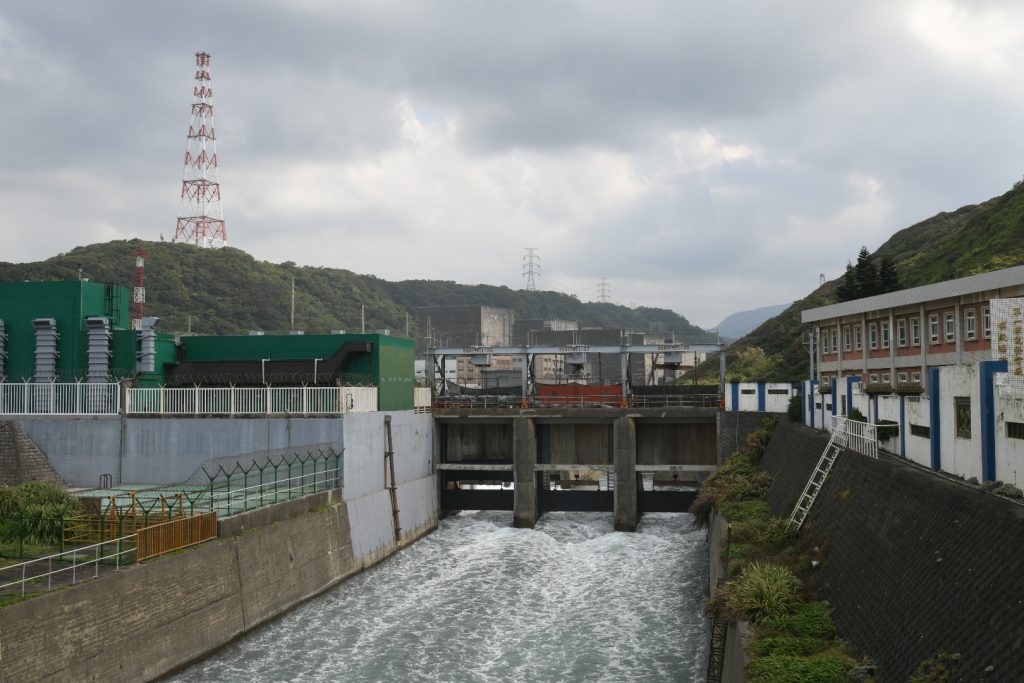
NPP No.1
NPP No.1 is only about seven km from NPP No.2. The reactors were permanently shut down on December 10, 2018 and July 15, 2019, 40 years after they were commissioned. The bus arrived by the Chinese temple just to the side of the bridge over the NPP water outlet. The group gathered around Mr. Guo on the bridge. There was a strong flow of water coming out of the NPP, situated in a narrow ravine, both reactor buildings clearly visible only a few hundred meters away. The reactors are still being cooled because the fuel rods are still in place – the spent fuel pools are full and the fuel rods cannot be removed. Thus, a serious earthquake could still result in one or both reactors going critical. Until the fuel is removed and stored safely, simply shutting the reactors down makes very little difference in terms of safety for local residents. A “field” has been created for dry cask storage, but the dry casks have not yet arrived. Where the spent fuel would go from there is not clear.
Mr. Guo told us that his home is near NPP No.1. He recalls playing all over the area as a child, and showed us photos of heavy equipment being brought up on the shore below the NPP site. When the NPP construction started, the villagers all moved away to different parts of Taiwan, losing contact with one another. He himself went to live and work in Taipei for 15 years, but moved back to oppose the NPP. Later NPP constructions were better in the way they managed the local residents, helping them to maintain contact and providing them with places to meet.
NPP No.4
The bus now had to travel about 25 km to the site of NPP No.4, sited in a small bay with a beach, Fulong Beach, known as a bathing spot. Since NPPs are generally situated on the coastline in a location with a beach, this limits the number of NPPs that can be constructed on Taiwan as the coastline is almost all rugged and rocky. The location is about 39 km from central Taipei, and only about 125 km from the nearest point in Japan, Yonaguni Island.
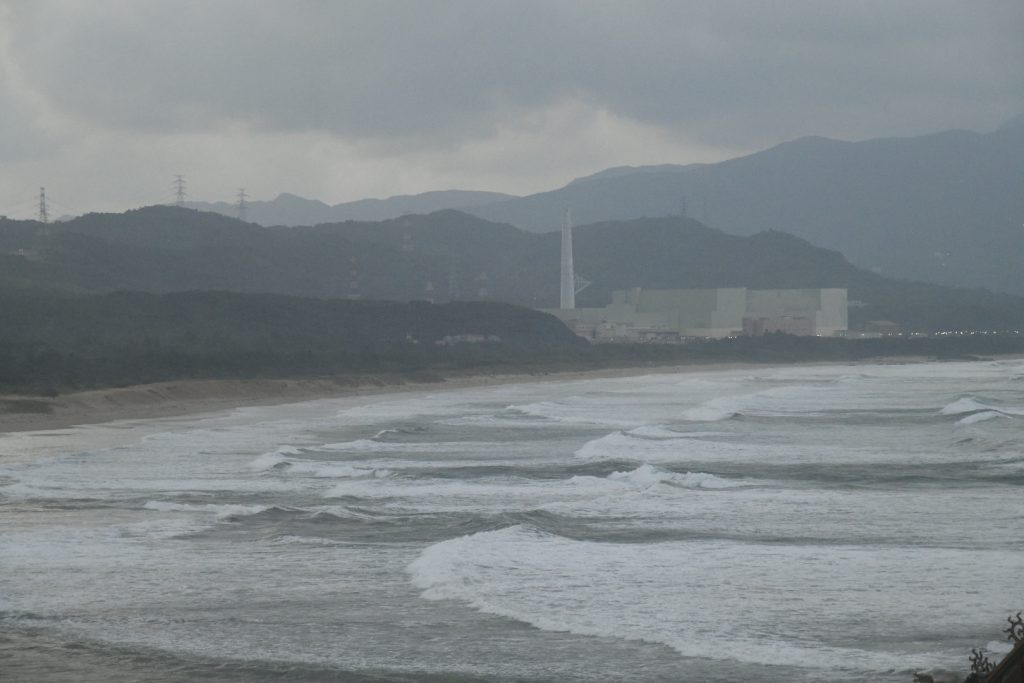
We were told that the changes in the flow of the water due to the NPP facilities has caused the beach to shrink. The two reactors are under construction but very close to completion and are plainly visible from anywhere nearby. The story is that the plot of land was originally laid out with double the space now occupied by the two reactor buildings. Exactly why is not clear, but there are two theories. One is that two further reactors would be constructed “once anti-nuke opposition dies down,” and the other is that a radioactive waste and spent fuel repository would eventually be built at the site. Since Units 1 and 2 are unlikely to be fully completed, the use of the empty land will remain ‘theoretical.’
Arriving at dusk, the bus drove up a narrow mountain road to a point where the bay, the beach and the NPP could be seen below. Very peaceful and pretty, and hopefully it will stay that way.
The group arrived at a seafood restaurant in the local town of Gongliao just before 7 pm. As we sampled the local delicacies, our host and anti-nuclear activist for over 30 years, Mr. Wu, gave us an introduction to the plant. The reactors (if ever completed) were 1350 MW ABWRs designed by GE, with reactors manufactured by Hitachi and Toshiba and construction carried out by Taipower. What is unusual is that the monitoring and control systems are combined in one system. There was no previous example of such a system, and thus a factor for anxiety. There was also a history of problems between Taipower and Toshiba regarding the size and power of the reactors. This led to a technical discussion between Mr. Wu and Mr. Goto Masashi, a former Toshiba NPP engineer, who is knowledgeable about the background to the construction of NPP No.4.
Mr. Wu then went on to say that he and others in Gongliao did not believe that they were in the clear yet. The pro-nuke interests, usually identified with the KMT, were still working hard to make a comeback, so there is still a long way to go before the local people can be confident that NPP No.4 will never be completed or operate. Therefore, the local opposition would like to cooperate with others inside and outside Taiwan to oppose the NPP. Lots of people have come to see the plant since the opposition campaign began in 1988. Mr. Wu said that it is possible that his movement will hold a big conference at the site and hope that everyone will come to stop the NPP. Furthermore, there will be a presidential and legislature election in January 2020. If President Tsai Ingwen is defeated, the NPP nightmare may begin all over again.
NPP No.3
NPP No.3 is located very close to the southernmost point of Taiwan, about 400 km from Taipei. It was therefore necessary to take the High Speed Railway (HSR), very similar to the Shinkansen, from Taipei to Kaohsiung, and then travel by tour bus from there to the NPP site and renewable energy sites that we were scheduled to visit.
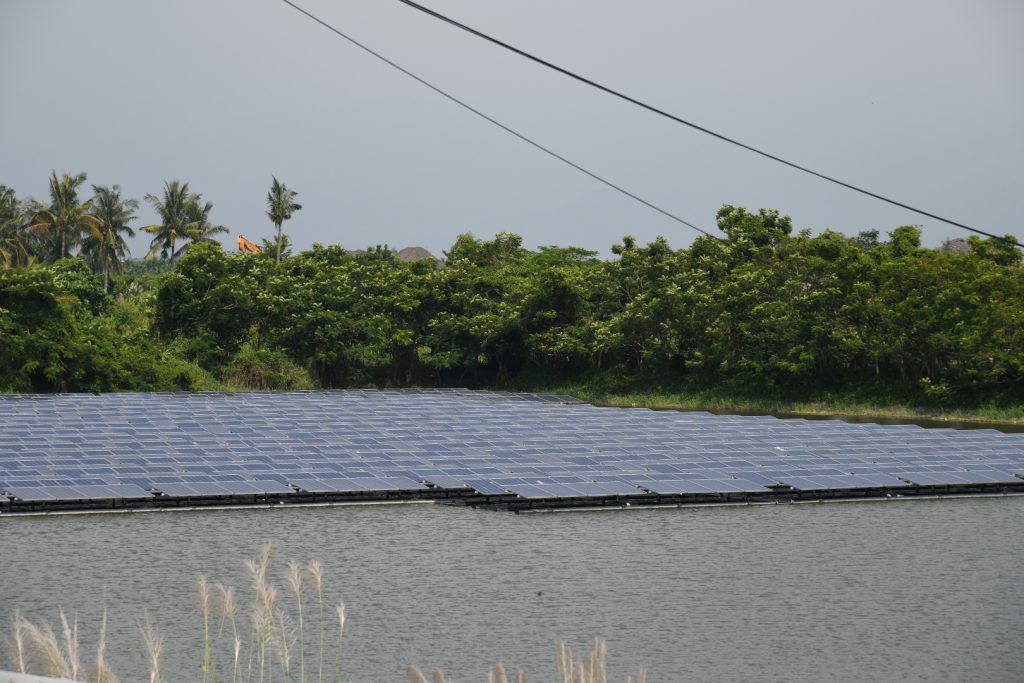
First we went to one of the renewable energy sites. This was a floating solar energy system. There to greet us was Lillian from the Pingdung County Government Green Energy Department and three engineers from the company that manufactured, installed and maintains the floating system. Lillian told us, in English, that the system is run by a private company, the government owns the rain retention pond and guarantees a good price for the electricity generated, and the local company ensures that the system abides by all legal requirements. Capacity of the floating panels was 499 kw, the panels covering 70% of the pond’s surface. The electricity was sold to the grid at a price of NT$5.5 (New Taiwan Dollars, 1NT$ = 3.5 yen). This particular floating solar system was set up in 2016, the first of its kind in Taiwan, but there are now 42 similar locations in Pingdung County. Other cities frequently send groups to study the system, which has now spread throughout Taiwan, something you can confirm by looking out of the train window as you speed through the countryside.

The second renewable energy site was a solar sharing vegetable farm. Vegetables are grown at ground level under a very sturdy concrete and glass structure, on top of which are placed solar panels. The panels are spaced about 1 m apart to allow sunlight through, and the special glass that forms the ceiling diffuses the light down into the vegetable growing area. In one of the buildings, which we were able to enter, there were rows of automatically irrigated crops, among which were Taiwanese chilis, a kind of melon, and Taiwanese bananas for export. When asked about yields, we were told that the red chili peppers gave 14 harvests per year, while the norm in the open air was eights harvests. Being in an enclosed area also meant that the crop was not vulnerable to weather problems, such as wind or rain, and that the use of pesticides was unnecessary. Total capacity of the solar panels was 3 MW.
The group then travelled in the bus to Hengchun Town Public Office for a meeting with local residents, who turned out to be elected members of the town council or public office employees.
Two presentations on Taiwan’s nuclear power and energy issues were first given by members of TEPU. The presentations were for the benefit of the hosts and were given in Chinese with very little interpretation (though some of the slides contained some English).
The hosts were then invited to speak. This caused problems as some of the local people spoke in Taiwanese, substantially different from the Mandarin Chinese that is the main means of communication in Taiwanese society today, causing our main Chinese to English interpreter, Dr. Linda Arrigo, to regret that she could only understand about 70% of what was being said. However, the main points were as follows.
1) What will become of the NPP site after decommissioning in 2025? Will that mean a loss of employment in the area? Perhaps the decommissioned NPP could be turned into a museum.
2) The nuclear waste should be removed.
3) The local people would like to have the ability to make more use of the National Park, which covers a large part of the area in the southernmost part of the county, except the NPP, which is technically outside the National Park.
All three of these opinions in some way involve tourism, which is the main source of income for the area. This appeared to disappoint the Taiwanese guests (mostly from Taipei), who felt that the local people did not understand the difficulties of the NPP decommissioning process and the length of time it would take (up to 50 years), including the removal of the nuclear waste, which might have to remain onsite until a “permanent” repository could be made available. That might mean a very long time indeed. Many of the participants felt that the local people lacked a robust vision for the future after the decommissioning of the NPP in 2025. This seemed to be a good example of how the same problem looks different from different perspectives.
The stance of the TEPU activists from the northern part of Taiwan, more ‘intellectual’ if I may say so, is that, especially after the Fukushima nuclear disaster in 2011, nuclear power is an absolute evil and must be totally eliminated, including, of course, finding some kind of permanent solution to the nuclear waste problem that does not simply involve burdening the people of Lanyu (Orchid) Island with it. The people close to NPP No.3 are far more relaxed, seeing NPP No.3 as a source of employment and money for the local community. They are more worried about what will happen to the local economy than they are about a possible nuclear accident. Thus the need for activist-intellectuals to come down to the “forgotten” south to give presentations that perhaps are only partly understood by the locals, even the elected councilors and public office employees.
The meeting finished at 6pm, when the group was taken for dinner at a local restaurant and then to a fabulous resort hotel (as if we had suddenly found ourselves in Hawaii) for the night.
The bus left the hotel at 0815 the next morning, firstly driving past NPP No.3 about seven minutes after departure. The two reactor buildings of the NPP are plainly visible on the left, across a beautiful beach and small bay. To the left of the NPP are three large wind turbines, one of which was rotating. A dozen or so people were bathing or sunning themselves on the beach not more than a few hundred meters in full view of the NPP, which caused some of the Japanese participants to gasp audibly.
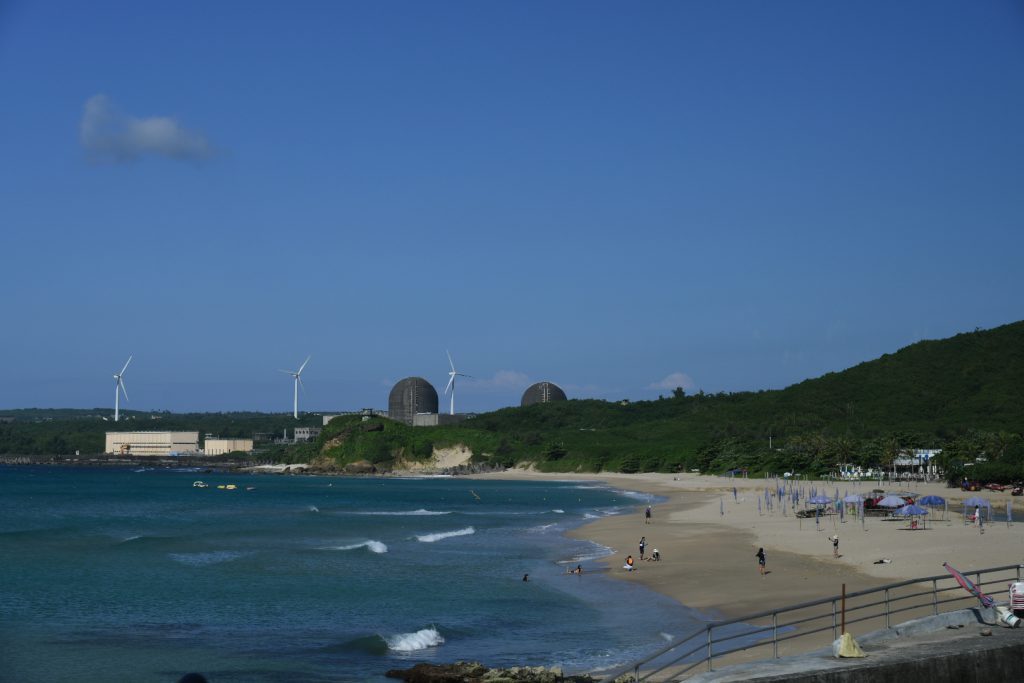
The bus climbed the hill and turned the corner to come to a stop in the car park at the entrance to the NPP. The electronic board over the entrance welcomed visitors and proclaimed an output of 997 MWe from Unit 1 and 996 MWe from Unit 2 (which seems high for an NPP rated at 1780 MWe). The board also gave the local air dose as 0.049 μSv/hr. A handheld Geiger counter belonging to one of the participants appeared to suggest that the air dose was something like 0.16 μSv/hr.
After 15 minutes in the car park, the group reboarded the bus back to Pingdung City for a reception with the Magistrate (mayor) of Pingdung County and a press conference. Arriving at about 10.40, we were immediately ushered into the magistrate’s office. The magistrate is Mr. Pan Men-an of the Democratic Progressive Party and he has been in the position since December 2014.
In his greeting, the magistrate explained how Pingdung is moving forward with the energy transition away from both nuclear power and coal thermal and towards renewable energy and power generation by LNG. He was positive about the nuclear phaseout, adamant that it would take place, and stated that Pingdung County was working with the central government to provide environmental protection for the NPP site and also to plan what needs to be done after NPP No.3 is decommissioned.
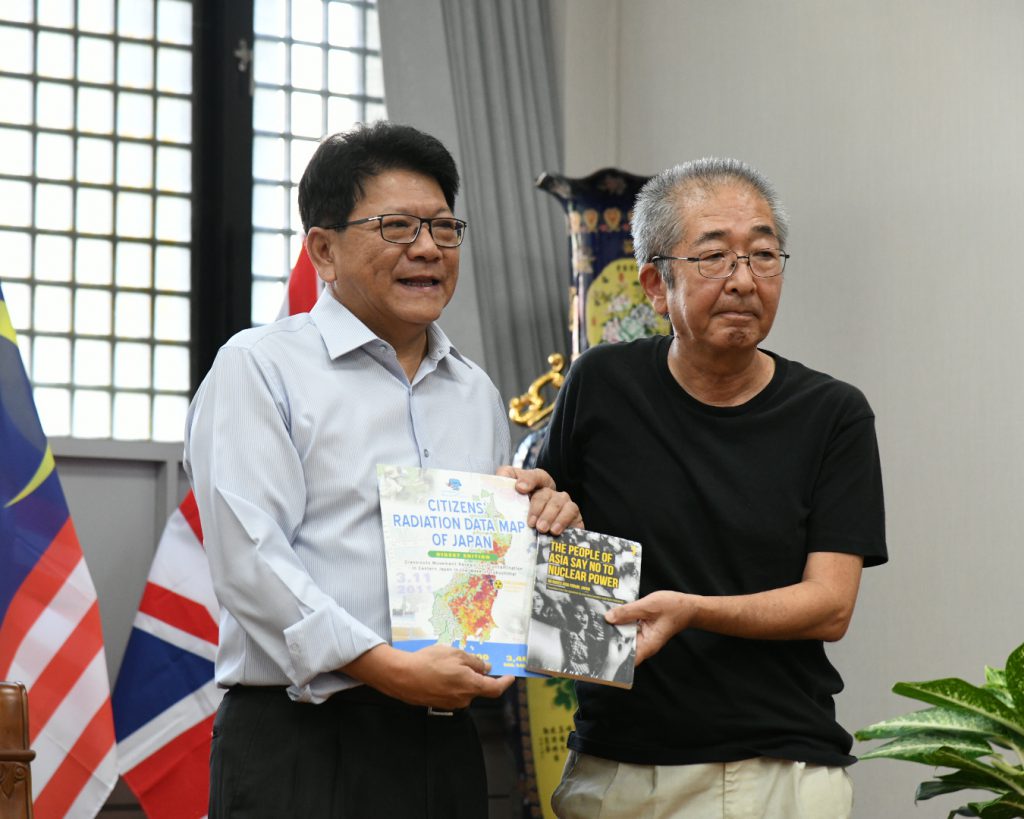
Short speeches were made by Sato Daisuke, General Secretary of NNAF, and Dave Sweeney. Mr. Sweeny praised Pingdung County for its energy transition away from nuclear power toward renewable energy, saying that Taiwan, California and Australia were at the forefront of the energy transition, which would bring challenges and opportunities for the people of Pingdung County. Mr. Sweeny expressed the view that Taiwan and Pingdung County could very well be a world leader in the energy transition towards renewables as they also worked to solve the challenges of employment and the final disposal of nuclear waste.
After a group photo, we moved to another building for a 25-minute press conference. Only four local reporters turned up to hear the overview of the NNAF meeting and speeches from the TEPU President Liu Zhijian, Sato Daisuke, Dave Sweeney and other TEPU officials.
An hour later, the group was disembarking from the bus at the entrance to Kaohsiung HSR station. I watched as the group, minus several participants who had split off at Pingdung to travel to Lanyu Island, ascended the escalator up into the station, and then descended in the opposite direction to take the local subway to my hotel.
3. Final Comments
The presidential and legislature election scheduled for January 2020 is shaping up as a straight race between the DPP’s Tsai Ingwen and the KMT’s Han Guoyu, who happens to be the current mayor of Kaohsiung. As of September 24, 2019, Tsai had a roughly 10-point lead in opinion polls. I took the opportunity of being in Kaohsiung to ask my friends and other people that I met what they thought of their mayor and his chances of being elected to the presidency. My friends are not anti-nuclear activists or environmentalists, nor are they members of political parties. I also do not know what their political preferences are. They are well-educated people in their 30s. The other people I talked to were people I met by chance on the street, in stores or at markets (market vendors). Surprisingly, I could not find one person who had anything positive to say about the mayor and they all doubted that he would win the presidential election.
When I explained to my friends why I was in Taiwan this time, they were interested in the idea of the nuclear phaseout, but expressed doubts. The main problem was they could not believe that a stable and sufficient energy supply could be maintained if nuclear power was phased out at the same time as power generation from coal thermal is reduced. The general feeling was that the very polluting coal thermal should be reduced while maintaining nuclear power. (Kaohsiung is Taiwan’s major industrial city. Though better now, air pollution in the city has been extremely serious until recent years. Many people on the street still wear face masks. The global warming issue has also contributed to positive feelings about nuclear power.) They also did not believe that renewables had an important role to play. Being from Kaohsiung, it seemed to them that renewables were irrelevant to heavy industry. A friend of a friend, who works for a steel company in Kaohsiung, even went as far as to say that renewables were “a fraud.”
However, not all electric power is used in heavy industry. My friends were not aware of the small percentage of power now provided by NPPs in Taiwan, nor were they aware of the details of the government’s plan to raise the share of power generation by LNG to 50% while reducing the share of coal thermal. The DPP clearly needs to make a greater effort to educate the population as part of their election campaign.
I also felt that my friends were remarkably nonchalant about the possibility of a nuclear accident, including some future problem with nuclear waste. This seems to be a very common problem in the south of the island, but less so in the north, around Taipei. While they did know about the Fukushima nuclear disaster, they appeared to assume that it would never happen to them. Assuming it will never happen to you is surely a common human trait, but the Fukushima disaster showed once again just how us dangerous it is. Taiwan has roughly the same land area as Kyushu (36,190 km2 to 36,750 km2) and has a little under three times the land area of Fukushima Prefecture (36,190 km2 to 13,780 km2). A major nuclear accident on the scale of Chernobyl or Fukushima would devastate Taiwan’s society and economy. The people of Taiwan should do everything in their power to ensure such an accident never occurs. In the light of this, even phasing out nuclear power by 2025 looks somewhat inadequate.
Possibly the greatest factor that works in favor of the nuclear phaseout in Taiwan is that Taiwan has only eight nuclear reactors, two of which are incomplete and two of which have now begun the process of shutdown and decommissioning. Prior to March 2011, there were 54 nuclear reactors operating in Japan. The economic/financial and political complexities of a nuclear phaseout in Japan are mind-boggling. Not impossible, but difficult, and will need to take place over a very long time scale. At the same time, Japan survived very well with zero nuclear power for some years after the Fukushima nuclear disaster.
The most intractable problem, however, as everywhere, is what to do with the nuclear waste. Above all, this is perhaps the most irresponsible element in the whole nuclear power and uranium industry complex. No one I spoke with in Taiwan, nor any presentation that I heard, gave the slightest indication of how this issue might finally be resolved. To my knowledge, no one in the world has a truly satisfactory solution to this issue.
So, will Taiwan phase out nuclear power? Yes, I think so. Taiwan is now so far down that path that even if the KMT wins the election in January 2020 they will not substantially change the energy policy or nuclear phaseout policy of the current DPP government. To attempt to reverse the current policy would more than likely invite the kind of mass demonstrations that occurred in Taipei in March and April 2014. Looking at what has happened (and is still ongoing) in Hong Kong this year, I do not believe a KMT government would attempt to go down that path. We shall have to await the results of the election and subsequent events.
Finally, I would like to express my sincere appreciation to everyone in NNAF and TEPU for their tremendous hard work in organizing this very full five-day program for the NNAF 2019 meeting. Amazingly, everything was completed almost to schedule and visits, transport, meals and accommodation during the field trip were extremely well organized. Special mention should go to Dr. Linda Arrigo and Anne-Elise Lewallen for their interpretation on the road, making it possible to understand explanations and speeches in English and Japanese. (That means Chinese ↔ English, Chinese ↔ Japanese and English ↔ Japanese interpretations, no mean feat.)
Solidarity and comradeship with all participants, both Taiwanese and from other countries will remain in my heart as a beautiful memory of ten days of nuclear tourism in a small, tropical Asian country. Thank you and look forward to seeing you all again as we march toward a nuclear/uranium-free world!
The 2019 NNAF Statement is available here


